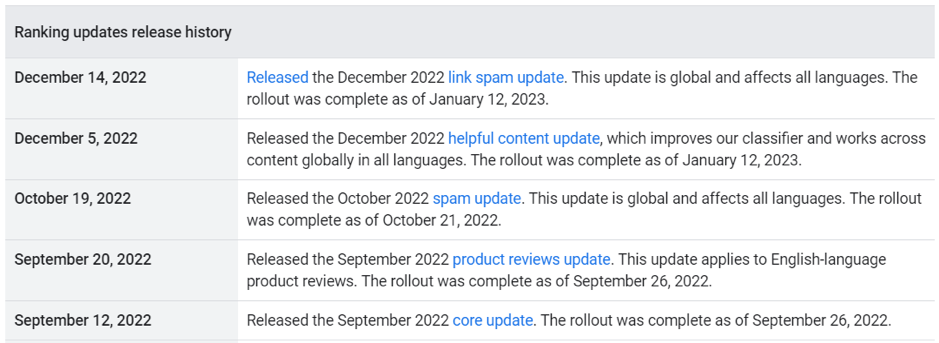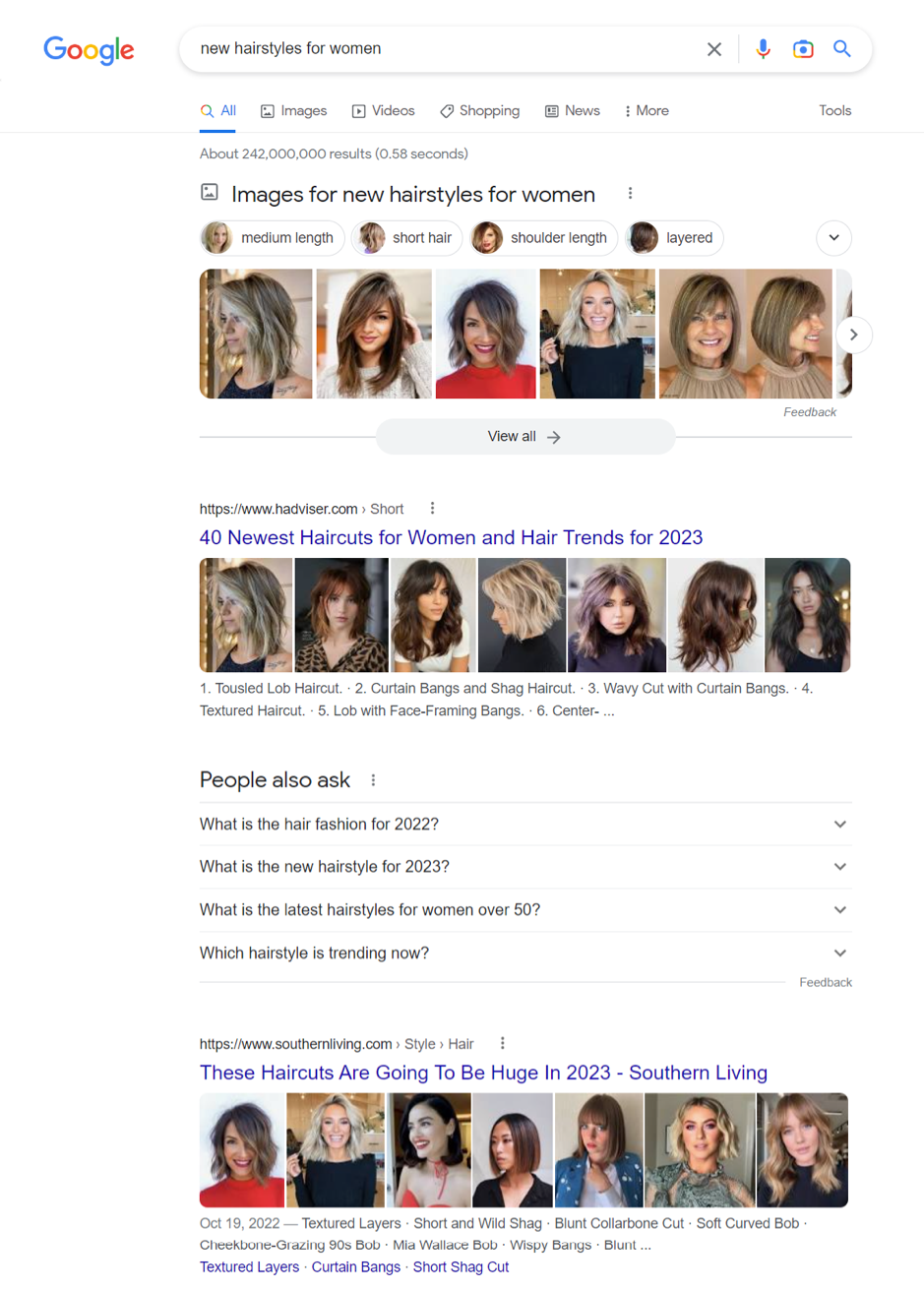SEO has evolved a lot in the past few years. Just when you think there is nothing more that Google, understands, it launches even more algorithmic updates.
In the last quarter of 2022, Google shook up the SEO industry and even some big players with five major updates back-to-back including the Core Update, Helpful Content Update and Link Spam Update.

Source: https://developers.google.com/search/updates/ranking
But change is the only thing that’s constant. Google updates shouldn’t hold SEOs back from trying to rank their clients’ businesses. After all, the fees that SEO agencies charge is worth only when the client gets qualified organic traffic from search engines.
So here are my five proven strategies that have helped my agency grow clients’ businesses manifold. Let’s dive in.
1. Create content in varied formats
How many times have you heard the phrase “Content is King?” A million times? But the fact is that it holds true even if it has now become clichéd. Without good content, there is no point in doing off-page SEO or link building activities to attempt and rank your site.
That doesn’t mean you have to create 3,000-word mammoth in-depth blog posts every time you want to express your brand’s views on a topic. On the other hand, in some cases you do need long-form content to rank for certain keywords.
Then there are other queries in which image or video results take precedence over written text. For example, if you have a fashion and lifestyle blog and are writing an article on “new hairstyles for women” you need to add real images, short videos and even embed social media posts from celebrities or influencers.
This helps Google understand that your content has something different as compared to the top 10 results present in the SERPs, and you have the expertise for that particular topic or niche. Google show the results accordingly.

Once you start creating content to include formats that Google is displaying in the SERPs for that particular intent, you’ll see a rise in your organic traffic.
2. Conform to EEAT standards
Google’s EAT guidelines played a major role in how they assessed content, especially for sites related to finance and health. EAT stands for Expertise, Authoritativeness, and Trustworthiness.
Recently, Google updated their search quality rater guidelines to include another E – experience – to the mix. Now Google will also consider the online reputation of the publisher or author of the content. In a nutshell, Google wants that the content creator to have actual knowledge and expertise in what they are talking about.
If you observe the Google SERPs for home improvement niches, such as carpet cleaning or mold removal, you’ll find most of the searches for purchase intent-based keywords have local businesses ranking on the top, even if they don’t have as much content as national brands.
This is because Google knows that these businesses are run by real people who have “experience” in the niche. Here’s what they have to say specifically:
Low quality pages often lack an appropriate level of E-E-A-T for the topic or purpose of the page. Here are some examples:
- The content creator lacks adequate experience, e.g. a restaurant review written by someone who has never eaten at the restaurant.
- The content creator lacks adequate expertise, e.g. an article about how to skydive written by someone with no expertise in the subject.
- The website or content creator is not an authoritative or trustworthy source for the topic of the page, e.g. tax form downloads provided on a cooking website.
- The page or website is not trustworthy for its purpose, e.g. a shopping page with minimal customer service information.
If you are doing SEO for a brand that only has service pages on its website. The best strategy would be to get employees to write blog posts sharing experiences in different areas of the niches, and then map that content to your targeted keywords.
Within the content, you could have the creator embed actual photos and even record a short video. You could then get all staff members or the whole team to share these videos and images on their TikTok, Instagram, YouTube and other social accounts with a link back to the content.
All this might sound like a lot of effort but if you want to improve the E-E-A-T factors in your content, you need to show as much social proof as possible.
3. Backlinks – the core of the ranking algorithm
No matter how good the content is, expecting it to rank will lead to disappointment if you do not promote it on relevant sites. Even though Google plays down the importance of backlinks, they play THE MOST significant role in improving SERP rankings
However, you may get penalized if you do it the wrong way. So there are two go-to strategies that I use for building links.
One is of course available right here on this site! That is Serpzilla, which is great for building different types of links. Serpzilla helps SEOs find contextual and relevant links for every niche.

Moreover, Serpzilla does this at scale, while adding some more great features like:
- Vetting various metrics like traffic, site authority, spam score, and so on.
- Identifying links within your budget.
- Helping you build links at your pace, however many you want.
- Making sure the link stays on the target site for a long time.
The other strategy is directly pursuing guest posts – the only form of high quality link building that works. For this, we use OutreachMantra – a marketplace that helps you find publishers in your niche. This saves you valuable time in manual outreach because you’re directly contacting relevant publishers who might be interested in linking to your content.
Whatever your preferable strategy, make sure you only build relevant links with varying anchor text. And always fulfil the promise of the link with your content.
4. Make internal links wisely
Interlinking relevant blog posts and service pages should be part of your regular on-site SEO as well as content creation checklist. You are losing the opportunity to rank more of your content and pages, faster if you do not properly use interlinks to relevant pages of your site.
Interlinking helps Googlebot discover new pages as well as pass “link juice” (for want of a better term) from your strong pages – the ones that have more authority – to others that have less.
When you have a good strategy involving topic clusters with primary pages and secondary pages for each topic, then it becomes easy for you to create associations between different pages. Don’t forget to vary your anchor text and choose ones that make sense.
 5. Keep updating existing content
5. Keep updating existing content
If you have over a hundred content pieces or blog posts on your website, it goes without saying that the old articles need to be updated. Google prefers content that is updated periodically because that means it is providing updated information to its users – in line with its vision of organizing the world’s information and make it universally useful.
You don’t need to add content for the sake of content but as your blog gets older and your industry changes, you sure need to change a few guidelines and best practices here and there. Every business is an information business today and there is no way your brand can be seen as behind the times by your audience.
If you demonstrate adequate updated knowledge in your field, it follows that more visitors will flock to your website.
Wrapping Up
I hope you liked this refresh of evergreen SEO strategies that increase organic traffic. Some tactics such as building backlinks, internal linking and optimizing your content for E-E-A-T will yield good results immediately and I strongly recommend you to try them out ASAP.
For other strategies and overall SEO results, you must be consistent and patient. SEO is not an overnight thing. It is like planting a seedling on fertile soil (content), adding high-quality fertilizers (technical SEO) and sufficient water (backlinks) to it regularly to get a great farm (business).






